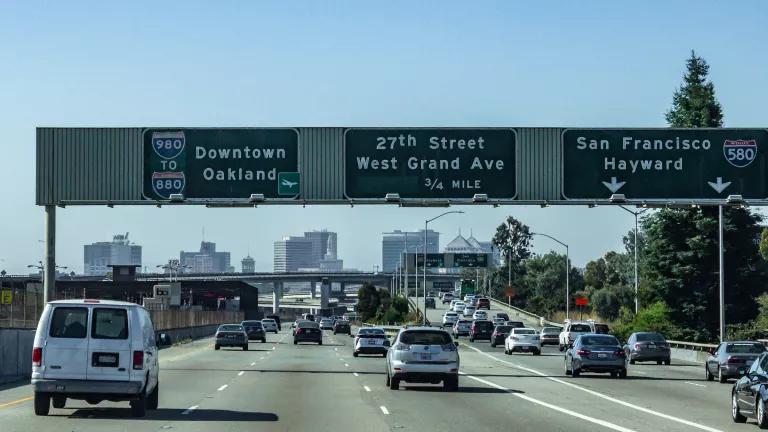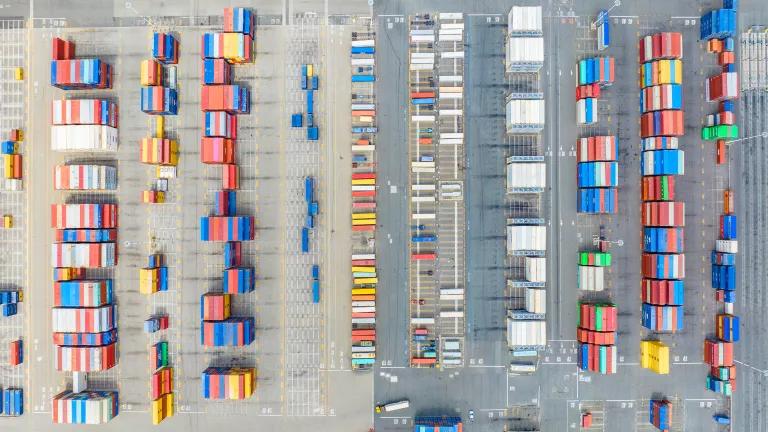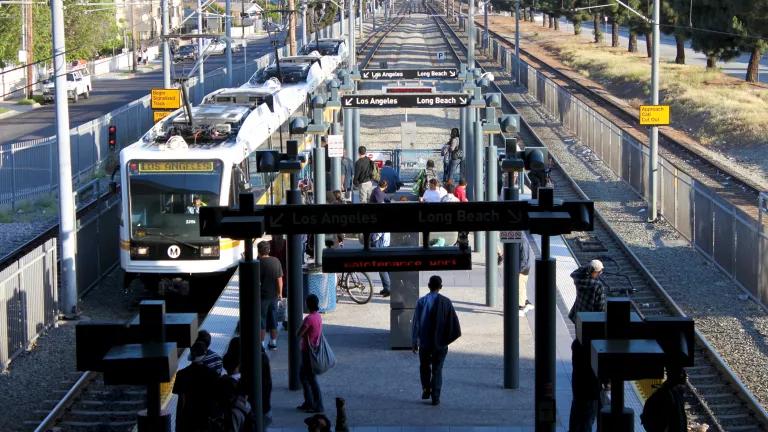
Photo by Alex Bello on Unsplash
California clearly took the news that it hosts 6 out of the top 10 most diesel polluted cities personally. Today, the California Air Resources Board (CARB) acted to combat toxic freight pollution by adopting two regulations: the Advanced Clean Fleets (ACF) Rule and the In-Use Locomotive Rule. The adoption of these new rules was enabled by the tireless advocacy over decades by frontline communities and will accelerate the deployment of zero-emission trucks and cut pollution from locomotives, resulting in cleaner air and a healthier environment for all Californians.
When almost every Californian lives in an area impacted by poor air quality, these regulations will save lives.
What Does the ACF Rule Do?

Photo by Dillon Kydd on Unsplash
The ACF rule has four main components:
- Drayage Truck Requirements: Starting on January 1st, 2024, only zero-emission drayage trucks – generally diesel-fueled, heavy-duty tractors that move containers and bulk freight between ports, intermodal rail facilities, and distribution centers- can be added to California’s drayage registry. Additionally, old drayage trucks must retire at the end of their useful life to meet the Governor’s target of all drayage trucks being zero-emission by 2035.
- State and Local Fleet Requirements: By 2024, 50% of new truck purchases must be zero-emission and all new truck purchases must be zero-emission by 2027.
- “High-Priority” and Federal Fleets Requirements: Includes fleets with $50 million or more of gross annual revenue; fleets of 50 or more trucks; and federal fleets. These fleets must comply with either the Model Year Schedule or the Zero-Emission Vehicle Milestones Option.
- Model Year Schedule: Beginning in 2024, fleets must purchase only zero-emission vehicles and starting January 1st, 2025, must remove internal combustion engine vehicles at the end of a useful life period of 18 years.
- Zero-Emission Milestones Option: Fleets may choose to meet zero-emission vehicle targets as a percentage of their total fleet, starting with vehicles that are the most suited for electrification.
Optional Zero-Emission Vehicle Milestone Phase-in
| ZEV Fleet Percentage | 10% | 25% | 50% | 75% | 100% |
| Box trucks, vans, 2-axle buses, yard trucks, light-duty package delivery vehicles | 2025 | 2028 | 2031 | 2033 | 2035 and beyond |
| Work trucks, day cab tractors, 3-axle buses | 2027 | 2030 | 2033 | 2036 | 2039 and beyond |
| Sleeper cab tractors and specialty vehicles | 2030 | 2033 | 2036 | 2039 | 2042 and beyond |
- Zero-Emission Vehicle Manufacture Sales Requirement: By 2036, all new truck sales must be zero emission.
Together, these four provisions will drive down emissions from California’s transportation sector and accelerate progress to a cleaner, more sustainable future.
What Does the In-Use Locomotive Rule Do?

Photo by Craig Marolf on Unsplash
The In-Use Locomotive rule has five components:
- Spending Account: Railroads must deposit funds into an account every year depending on the emissions from their locomotives. Before 2030, these funds may only be used for Tier 4 or zero-emission locomotives or infrastructure. After 2030, funds are restricted to zero-emission locomotives or infrastructure only.
- Operating Requirements: Beginning in 2030, locomotives that are 23 years or older must be zero emission to operate in California. Additionally, switcher, passenger, and industrial locomotives manufactured beginning in 2030 must operate in zero emission mode in California. Lastly, line-haul locomotives manufactured beginning in 2035 must operate in zero emission mode in California.
- Idling Requirement: A new requirement was adopted limiting locomotive idling to 30 minutes unless an exemption applies.
- Recordkeeping and Reporting: Operators must now report annual locomotive activity by California air district.
The rule permits an alternative compliance pathway if locomotive operators submit a plan showing that by alternative means they can achieve the same or greater emission reductions.
Clean Freight Standards Are Central to California’s Zero-Emission Transportation Strategy
The ACF and In-Use Locomotive rules are key parts of a suite of policies by California to accelerate the market for zero-emission trucks, vans, rail, off-road vehicles, and buses and cut down on toxic air pollution. California is prioritizing cleaning up diesel pollution from the goods movement industry because this is one of the fastest-growing sources of greenhouse gas emissions, a dominant source of California’s NOx pollution, and one of the largest sources of air pollution disparity in the United States.

Photo by Ronan Furuta on Unsplash
Substantial Public Health & Air Quality Benefits
The In-Use Locomotive rule will result in 63 tons per day in Statewide NOx emissions reductions and over 3,200 avoided premature deaths. In all, this is estimated to save about $32 billion in health costs.
This is especially critical in the South Coast region where the Ports of LA and Long Beach – the largest port complex in the country – are served by a massive system of railyards. Pollution from the railyards and locomotives is a significant contributor to the South Coast Air Basin’s nonattainment of federal air quality standards for PM2.5 and ozone.
By 2030, locomotive emissions are projected to contribute 14 percent of the state’s PM2.5 freight emissions and 16 percent of the state’s NOx freight emissions.
Meanwhile, from 2024 to 2050, the ACF rule is expected to produce the following health benefits:
- 2,526 avoided cardiopulmonary deaths;
- 401 avoided hospital admissions for cardiovascular illness;
- 478 avoided hospital admissions for respiratory illness; and
- 1,177 avoided ER visits for asthma.
These avoided harms translate to $26.5 billion in statewide health benefits from reductions in criteria pollutant emissions. Finally, the ACF rule will also reduce additional cardio and respiratory illnesses, nonfatal and fatal cancers, and lost workdays that were not included in CARB’s analysis.
Together, these rules will save thousands of lives.
Stimulating the Economy and Promoting Innovation
Utilizing zero-emission trucks will bring significant economic benefits to Californians. The bulk of these benefits will come in the form of fuel and maintenance cost savings. The ACF rule alone is expected to bring net cost savings of $48 billion to fleets. A recent study illustrates that the total cost of ownership for several types of medium and heavy-duty vehicles will be less expensive than their diesel counterparts by 2027.
Manufacturers are already responding to market forces and are committed to producing more zero-emission models. In 2019, there were only 20 models of class 2b-8 zero-emission trucks. By the end of 2022, there were over 544 models.
Key federal incentives are also building the foundation of the zero-emission vehicle market. The IRA contains tax credits of up to $7,500 for light- and medium-duty vehicles and up to $40,000 for heavy-duty trucks. Additionally, the federal tax credit on charging equipment has been extended through December 31st, 2032. For individual/residential uses, the tax credit remains unchanged at 30%, up to $1,000. For commercial uses, the tax credit is 6% with a maximum credit of $100,000 per unit (up from $30,000 per property).
Federal incentives are bolstered by state and local investments, such as LA Metro’s $50 million allocation for zero-emission trucks and infrastructure—the culmination of years of community advocacy. These incentives are supporting a thriving zero-emission vehicle market; the future is here, and the time is now to eliminate toxic air pollution.

Photo by Akshay Nanavati on Unsplash
Additionally, the In-Use Locomotive rule will spur innovation, investments, and the deployment of zero-emission locomotives in California.
Across the world, electric freight locomotives are utilized in many countries. However, in the United States, we continue to use decades-old locomotive engines, with deadly consequences for neighboring communities.
This mandate to clean up rail is necessary. For example, Class I railroads in CA operate an average of Tier II locomotives, which has been the case since 2010. Yet, for years Tier 4 locomotives have been available and can provide emission reductions of 80 percent or more compared to Tier 3 locomotives. Locomotive pollution is not being cleaned up voluntarily, and Californians cannot wait any longer.
In 2027 and 2032, CARB will publish technology assessments on zero-emission locomotive technology. In the interim, CARB should also revisit idling limits to reduce this significant source of pollution in communities, and identify additional measures to cut rail pollution in the near-term.
Conclusion
While there is still more work that needs to be done, the adoption of these rules sends a strong signal that California is invested in safeguarding public health for the long haul. These regulations will help Californians live longer, healthier lives, especially in communities of color and low-income communities that have been exposed to toxic air pollution for far too long. Californians can breathe easier knowing that their state is committed to cleaning up freight pollution and making progress on its climate goals.
This blog provides general information, not legal advice. If you need legal help, please consult a lawyer in your state.




